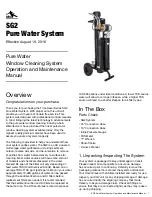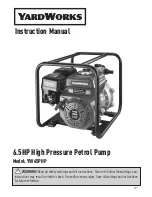
Operation
Sanitize the Pump Before First Use
It is the user’s responsibility to properly sanitize
the pump before first use. It is up to the user
whether this will include disassembling and cleaning
individual parts or simply flushing pump with a
sanitizing solution. As necessary, follow the steps
under
Start and Adjust the Pump, page 18
, or
Transfer Mode Vs. Low Pulsation
Mode
When the air pressure is at least 0.7 bar (10 psi)
higher than the desired outlet pressure, the pump
is in Transfer Mode and no pulsation damping
is occurring. To reduce outlet pulsation, start by
setting the air pressure equal to the desired outlet
fluid pressure. Continue to adjust the air pressure
relative to the outlet fluid pressure. Lower relative air
pressures produce more pulsation damping. Higher
relative air pressures produce better pump efficiency.
Start and Adjust the Pump
1. Be sure the pump is properly grounded. See
2. Check fittings to be sure they are tight. Use a
compatible liquid thread sealant on male threads.
Tighten fluid inlet and fluid outlet fittings securely.
3. Place the suction tube (if used) in fluid to be
pumped.
NOTE: Iffluid inlet pressure to the pump is more
than 25% ofoutlet working pressure, the ball
check valves will not close fast enough, resulting
in inefficient pump operation.
NOTICE
Excessive fluid inlet pressure can reduce
diaphragm life.
4. Place the end of the fluid hose into an appropriate
container.
5. Close the fluid drain valve.
6. Turn the air regulator knob to match the desired
fluid stall pressure. Open all bleed-type master
air valves.
7. Ifthe fluid hose has a dispensing device, hold it
open. Be sure all fluid shutoff valves are open.
8. Set the desired frequency on the VFD.
9. Press the start (run) button on the VFD.
10. Ifyou are flushing, run the pump long enough to
thoroughly clean the pump and hoses.
18
859.0769
















































